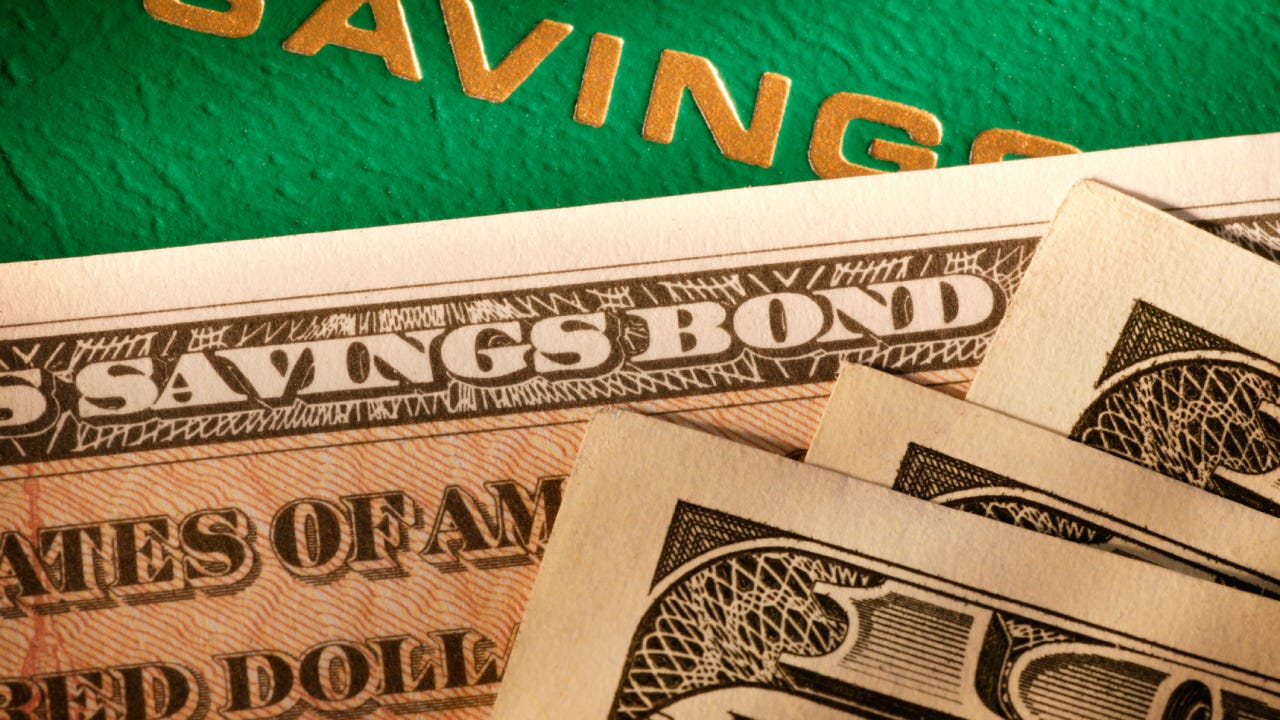How to give a savings bond as a gift

The Bankrate promise
At Bankrate we strive to help you make smarter financial decisions. While we adhere to strict , this post may contain references to products from our partners. Here's an explanation for .
Our writers and editors used an in-house natural language generation platform to assist with portions of this article, allowing them to focus on adding information that is uniquely helpful. The article was reviewed, fact-checked and edited by our editorial staff prior to publication.
Birthdays, graduations and other special occasions are usually celebrated with a gift. It’s a common way to wish your loved ones well. If you’re looking for gift ideas for family or friends, you might want to consider a savings bond.
A savings bond isn’t just a one-time present but rather an investment in the recipient’s future. Bankrate’s 2024 emergency savings report revealed just 44 percent of respondents have an adequate savings fund, so a savings bond is one way to contribute to long-term savings goals. Here’s what you need to know about giving a savings bond as a gift.
What is a savings bond?
A savings bond is a government-backed debt security that can be purchased in your name or as a gift for someone else. They’re seen as one of the most secure investment options, thanks to the backing of the U.S. government.
“It’s a U.S. Treasury-issued loan where you are loaning money to the U.S. government in exchange for interest back,” explains Katie Brewer, CFP and owner of Your Richest Life.
Savings bonds accrue interest over time and can be cashed in after a certain period, typically from one to 30 years. The money invested is secure and steadily grows, making it a reliable and low-risk investment.
Types of savings bonds
The two main types of savings bonds are Series EE and I bonds. Series EE bonds earn interest over 30 years (or until you redeem them).
Bonds purchased now are guaranteed to double in value in 20 years. The current interest rate for Series EE bonds issued between November 1, 2023, and April 30, 2024, is 2.70 percent.
Series I savings bond interest rates change every six months depending on inflation. The interest rate on I bonds is made up of a fixed and an inflation-based component.
While the fixed rate remains constant, the inflation-adjusted portion resets every six months. This causes the overall I bond interest rate to change accordingly. The current interest rate for I bonds issued between November 1, 2023, and April 30, 2024, is 5.27 percent.
Factors to consider when gifting a savings bond
Before purchasing a savings bond as a gift, there are a few things to consider. Bear in mind the recipient’s goals and circumstances.
“Take into account the receiver’s financial goals before deciding on which bond to gift,” says Jonathan Feniak, head of finance at Company Sage and general counsel at LLC Attorney. “Avoid gifting savings bonds if the recipient needs cash right away.”
There’s a penalty associated with redeeming a bond prematurely. Savings bonds cashed within the first five years of issue result in a loss of the last three months of interest.
Next, consider the type of bond that would be most beneficial. Series EE and Series I bonds, for instance, have different interest rates and inflation adjustment policies. Series I bonds might be best for someone with a long-term goal since they protect the owner against inflation. Finally, understand the tax implications involved in the gifting process.
How to give a savings bond as a gift
You can purchase savings bonds through the TreasuryDirect website. Make sure you have the recipient’s full name, Social Security number (or Taxpayer Identification Number) and TreasuryDirect account number.
Steps to purchase a savings bond as a gift
Here’s how to purchase a savings bond as a gift in six steps:
- Log in to your TreasuryDirect account and select BuyDirect from the main menu.
- Choose the type of bond you wish to purchase (either Series EE or Series I).
- Select “gift” in the registration type.
- Enter the recipient’s full name and Social Security Number or Taxpayer Identification Number.
- Choose the amount you want to purchase (minimum of $25).
- Review and submit your purchase.
Once the purchase is complete, the bond will be delivered to the recipient’s TreasuryDirect account.
Benefits of gifting a savings bond
Gifting a savings bond comes with benefits. Unlike other gifts, a savings bond appreciates over time, providing the recipient with more than just the initial investment.
Savings bonds also encourage and promote the habits of saving and investing. Furthermore, it’s a secure and low-risk gift option. The recipient is guaranteed to receive the face value of the bond plus accrued interest.
“One of the benefits of savings bonds is you know it’s a safe investment,” says Brewer. “Unless the U.S. government goes out of business, it’s backed by the U.S. government. It’s not a speculative investment.”
How savings bonds contribute to future financial security
Savings bonds, especially when gifted to children or young adults, can contribute to future financial security. They can be used for various purposes, such as paying for higher education, starting a business or buying a house. Moreover, they teach the importance of patience when investing, as bonds take time to fully mature.
How to track the value of savings bonds
TreasuryDirect’s Savings Bond Calculator allows bondholders to track the value of their bonds. They simply need to enter the series, denomination and issue date. The tool will show its current value and interest earned.
Maximizing returns on a savings bond involves retaining the bond until it stops earning interest. This is typically 30 years from the issue date for both Series EE and Series I bonds.
Tax implications of gifting and receiving savings bonds
Both gifting and receiving savings bonds have tax implications. Know that taxes must be paid on the interest earned by savings bonds when they’re cashed in. This interest is subject to federal income tax but not state or local income tax. However, some education-related tax exclusions may apply if the bond proceeds are used to pay for qualified education expenses.
Receiving a savings bond as a gift doesn’t trigger immediate tax implications. The recipient will only owe taxes on the interest earned by the bond when it’s cashed in.
However, it’s important to note the gift tax may apply to the giver if the value of the bond, plus any other gifts to the same person, exceeds the annual gift tax exclusion, which is $18,000 in 2024.
Dos and don’ts of gifting a savings bond
Before gifting a savings bond, there are a few dos and don’ts to consider.
Do:
- Consider the recipient’s financial situation and goals before gifting a savings bond.
- Remember that savings bonds are a long-term investment and not suitable for those with immediate financial needs.
Don’t:
- Don’t forget about the tax implications for both the giver and the recipient.
- Don’t overlook the different types of bonds available and their respective features and benefits.
Bottom line
A savings bond provides a low-risk option for financial security. When purchasing a savings bond as a gift, consider the recipient’s financial goals, understand the types of bonds available and be aware of the tax implications. The next time you’re looking for a meaningful gift, consider a savings bond and help your loved ones secure their financial future.
FAQ
-
Both the giver and recipient need a TreasuryDirect account for electronic EE or I bonds. A child’s account must be linked by a parent or custodian. Paper Series I bonds can also be purchased with an IRS tax refund in various denominations.
-
You can buy anywhere from $25 to $10,000 in Series EE bonds per calendar year. In addition, you can purchase $25 to $10,000 in electronic I bonds and from $50 to $5,000 for paper I bonds.
-
A $100 Series EE bond will stop earning interest after 30 years and its value will depend on the interest rate it earns. Bonds issued after May 2005 are guaranteed to double in value by 20 years, so it would be worth at least $200 by then. To find the exact value at 30 years, you can use the TreasuryDirect website’s calculation tools.
-
The savings bond must remain in your account for at least five business days before delivery. This ensures the funds have been processed successfully.
-
Certificates of deposit (CDs), savings accounts, and high-yield savings accounts are alternatives to savings bonds. CDs, which offer a fixed rate of interest for the length of their terms, generally offer interest rates higher than traditional savings accounts, but you won’t reap the full benefits of your investment until the end of a CD’s term. The timeline is typically three months to five years, although there are terms that are as short as one month to as long as 10 years, even longer. Withdrawing funds before the CD matures will result in an early withdrawal penalty that can offset earned interest.
Standard savings accounts offer liquidity, but interest rates are usually lower. On the other hand, high-yield savings accounts offer liquidity and higher interest rates than CDs and standard savings accounts.
Related Articles



